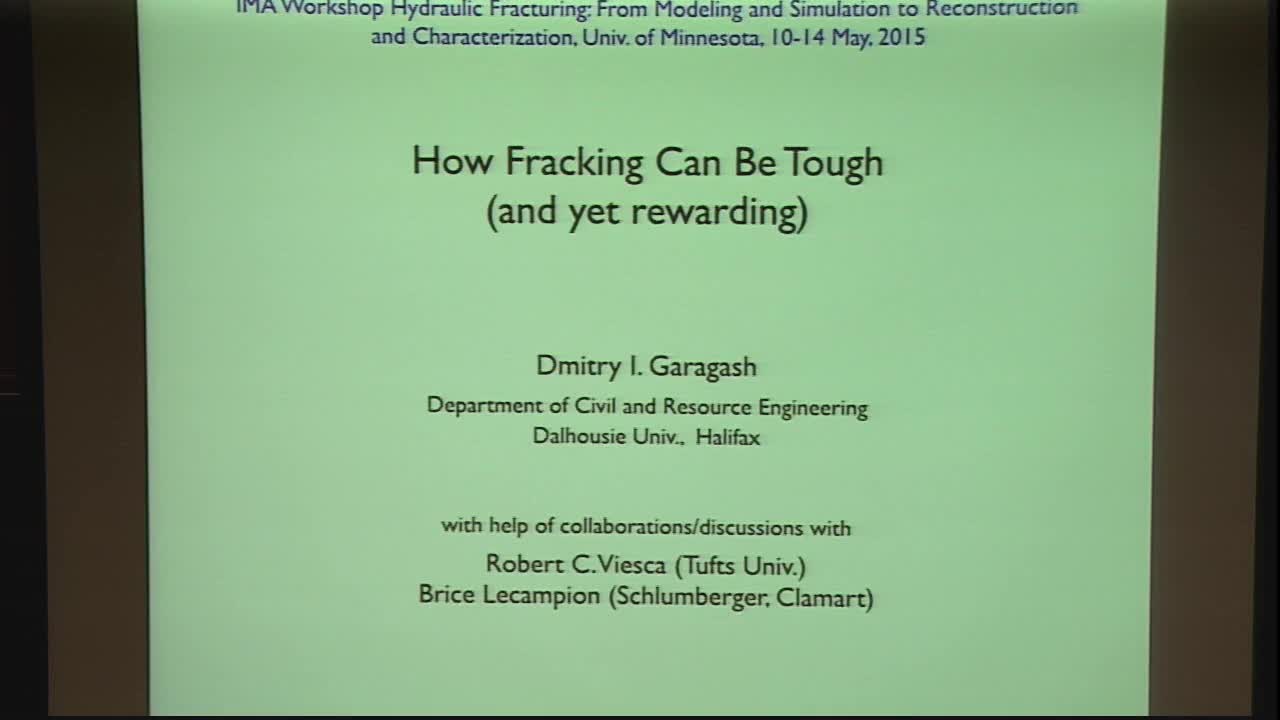How Fracking Can be Tough (and Yet Rewarding)
Presenter
May 13, 2015
Keywords:
- Fluid Mechanics
Abstract
Current understanding suggests that the energy required to propagate a hydraulic fracture is largely a function of the viscous fluid pressure drop distributed along the fracture channel, while the contribution to the energy dissipation from the immediate vicinity of the fracture front, referred to as the fracture toughness (fracture energy), is considered negligible. This status quo relies on the assumption of the Poiseuille flow everywhere along the fracture, in which the fracture transmissivity (flow rate per unit distance along the front per unit hydraulic gradient) is assumed to vary as the cube of the local aperture. We re-evaluate this assumption in the vicinity of the fracture tip, where the roughness of the fracture surfaces and/or branching/delocalization of the fracture path in the so-called process zone region may lead to very significant deviations form the cubic law. Existing relationships for rough fracture transmissivity suggest dependence on the aperture to the power between 4.5 to 6 when the aperture is smaller than the characteristic roughness scale. This is expected to lead to (a) larger energy dissipation in fracturing ("tough fracking") than predicted by the Poiseuille flow model; (b) localization of the fluid pressure drop to the near tip region with very low transmissivity; and, as the result, (c) emergence of potentially preeminent "toughness-dominated” fracture propagation regime where most of the energy is dissipated at the tip and can be described in the context of classical fracture mechanics by invoking the effective fracture toughness dependent upon the fine details of the viscous pressure drop in the low transmissivity tip region. We validate these conjectures by solving for the tip region of a steadily propagating hydraulic fracture with a "rough fracture” transmissivity relation. We establish that a single dimensionless number, given by the ratio of the fracture roughness scale w_c to the viscous aperture scale [Garagash & Detournay, 2000] $w_\mu = \frac{\mu VE}{(\sigma_0)^2}$, controls the localization of the pressure drop. (Here V - fracture propagation speed, $\mu$ - viscosity, E - plane strain modulus of the rock, and $\sigma_0$ is the in-situ confining stress). When this ratio is large, as shown to be plausible for typical slick-water and linear gel industry treatments, the pressure drop is fully localized, and the energy dissipation in the hydraulic fracture propagation can be fully described by the effective toughness dependent upon fracture propagation velocity, confining stress and material parameters. Estimated representative values of the effective toughness are much larger than the classical "dry” rock fracture toughness obtained in the lab. We then proceed to show, in the context of a radial (penny-shape) hydraulic fracture, how the main fracture parameters, such as the propagation distance, the mean fracture aperture/volume, and the fracturing pressure, are impacted by the effective, velocity-dependent fracture toughness; and how/when the classical viscosity-dominated and toughness-dominated solutions based upon the Poiseuille law and the "dry” fracture toughness values, respectively, may become inadequate.
The second part of this work addresses how the localization of the fluid pressure drop to the tip region of the hydraulic fracture may result in enlargement of the off-fracture-plane damaged rock region. The latter is expected to have enhanced rock permeability and therefore contribute positively to the reservoir stimulation.
